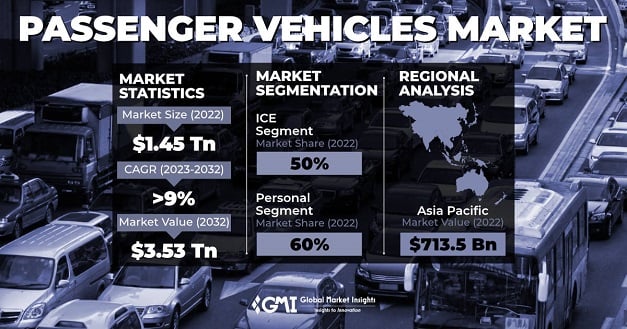Home > Automotive > Mobility > Passenger Vehicles > Passenger Vehicles Market
Passenger Vehicles Market Size
- Report ID: GMI7427
- Published Date: Nov 2023
- Report Format: PDF
Passenger Vehicles Market Size
Passenger Vehicles Market was valued at USD 1.45 trillion in 2022 and is anticipated to register a CAGR of over 9% between 2023 and 2032 as it is driven by the escalating environmental concerns and regulations worldwide. As consumer demand continues to grow, manufacturers experience increased sales, contributing to the overall market expansion. According to the Society of Indian Automobile Manufacturers, in 2022, the sales of passenger vehicles rose from 3,069,523 to 3,890,114 units between 2021-22 and 2022-23. This upward trend in passenger vehicle purchases reflects consumer preferences while stimulating innovation and competition among manufacturers, ultimately fostering a dynamic & thriving market for passenger vehicles.
Consumer demand, a pivotal factor for the passenger vehicles industry, is witnessing sustained growth. This surge is fuelled by evolving consumer preferences, lifestyle changes, and a desire for personalized transportation solutions. As consumers seek enhanced features, fuel efficiency, and advanced safety measures, manufacturers are compelled to innovate. The dynamic interplay between consumer expectations and industry innovation continues to shape the passenger vehicles industry, making it imperative for manufacturers to align their offerings with evolving consumer needs and desires.
| Report Attribute | Details |
|---|---|
| Base Year: | 2022 |
| Passenger Vehicles Market Size in 2022: | USD 1.45 Trillion |
| Forecast Period: | 2023 to 2032 |
| Forecast Period 2023 to 2032 CAGR: | 9% |
| 2032 Value Projection: | USD 3.52 Trillion |
| Historical Data for: | 2018 - 2022 |
| No. of Pages: | 250 |
| Tables, Charts & Figures: | 333 |
| Segments covered: | Propulsion, vehicle type, application, and drive type |
| Growth Drivers: |
|
| Pitfalls & Challenges: |
|
Rising fuel prices impede the passenger vehicles industry. As fuel costs escalate, consumers may reconsider their vehicle choices, favouring more fuel-efficient or alternative-fuel options. This shift in preference could affect the demand for traditional Internal Combustion Engine (ICE) vehicles, pressuring manufacturers to innovate in the electric and hybrid segments. Adapting to this change presents both technological and economic challenges, influencing market dynamics and requiring manufacturers to navigate a landscape increasingly shaped by environmental concerns and fuel price volatility.

